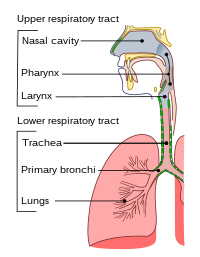
Photo from wikipedia
BACKGROUND AND AIMS There are growing concerns over the respiratory health of people who use illicit opioids due to high rates of opioid inhalation and tobacco smoking in this group.… Click to show full abstract
BACKGROUND AND AIMS There are growing concerns over the respiratory health of people who use illicit opioids due to high rates of opioid inhalation and tobacco smoking in this group. This study aimed to summarize the evidence relating illicit opioid use with poor respiratory health. METHODS A systematic review of the literature on the association between illicit opioid use and respiratory health was undertaken in accordance with PRISMA guidance (Prospero ID=CRD42017059953). Electronic searches of MEDLINE, Embase, PsycINFO, CINAHL and the Cochrane Library databases were undertaken (English language, published January 1980 - November 2018). All study designs excluding case studies were considered. Studies were undertaken in community and hospital settings in the US (n= 23), UK (n=7), Australia (n=7), Netherlands (n=2), Canada (n=2), Ireland (n=1), Spain (n=1) and Iran (n=1). Measurements of respiratory disease, including asthma and chronic obstructive pulmonary disease (COPD) and related symptoms were extracted. Data on respiratory related deaths and hospital admissions were also extracted. Meta-analysis of prevalence data was undertaken using a random effects meta-analysis model with parameters estimated using Markov chain Monte Carlo simulation. RESULTS Meta-analyses estimated prevalence of asthma in people who inject illicit opioids as 8.5% (95% predictive interval (PrI): 0.2%, 74.0%) and as 20.2% (95% PrI: 4.2%, 59.2%) in people who inhale illicit opioids. Prevalence of COPD in people who inject illicit opioids was estimated as 2.7% (95% (PrI): 0.0%, 50.4%) and as 17.9% (95% PrI: 0.6%, 89.5%) in people who inhale illicit opioids. There was evidence of moderate to extreme heterogeneity across studies. CONCLUSIONS There is evidence of increased burden of respiratory diseases in people who use illicit opioids. Due to heterogeneity of study design and samples it is difficult to gain accurate estimates of the prevalence of respiratory disease in this population.
Journal Title: Addiction
Year Published: 2019
Link to full text (if available)
Share on Social Media: Sign Up to like & get
recommendations!